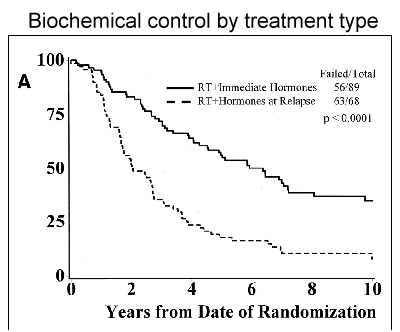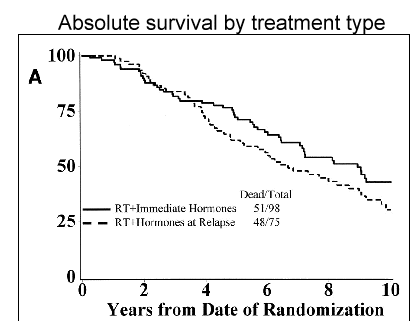| The most common approach if a patient is
found at surgery to have spread to the nodes, is to stop the surgery and treat the
patients with hormones, radiation or a combination. From the studies below an argument can
be made for any of these treatments. Most physicians will use both radiation combined with
hormones in younger patients. The best data os probably from the RTOG trial
Androgen Suppression Plus Radiation Versus Radiation Alone for Patients With Stage D1/Pathologic Node-Positive Adenocarcinoma of the Prostate: Updated Results Based on National Prospective Randomized Trial Radiation Therapy Oncology Group 85-31 Journal of Clinical Oncology, Vol 23, No 4 (February 1), 2005: pp. 800-807
|
||||
| J Urol 1994 May;151(5):1330-3 Early androgen ablation for stage D1 (N1 to N3, M0) prostate cancer: prognostic variables and outcome.Zagars. To elucidate the outcome for patients with stage D1 (N1 to N3, M0) prostate cancer we reviewed 179 patients with lymphadenectomy proved pelvic nodal metastases who underwent immediate androgen ablation as the only initial treatment. With a median followup of 43 months, the 5 and 8-year actuarial rates of freedom from disease progression were 55% and 25%, respectively, and the median interval to disease progression was 67 months. The 5 and 8-year survival rates were 85% and 57%, respectively. Median survival after disease progression was 36 months. Cancer 1992 Jun 1;69(11):2761-6 Is long-term survival possible with external beam irradiation for stage D1 adenocarcinoma of the prostate?Lawton CA. From 1972 to 1986, 354 patients with local and locoregional adenocarcinoma of the prostate were treated with curative intent at the Medical College of Wisconsin. Fifty-six of these patients were found to have Stage D1 disease (evidence of pelvic lymph node involvement). Using external beam irradiation alone, these patients were treated aggressively to the pelvis followed by a boost to the prostate. The median dose to the prostate was 6800 cGy, and to the pelvis, it was 5040 cGy. The median period of observation after treatment was 9 years. Actuarial survival was 76% at 5 years, and disease-free survival was 61% at 5 years. Urology 1994 Nov;44(5):719-25 Adjuvant radiation, chemotherapy, and androgen deprivation therapy for pathologic stage D1 adenocarcinoma of the prostate.Freeman JA. A retrospective analysis of the results of an
aggressive multimodal approach combining radical prostatectomy with adjuvant radiation,
chemotherapy, or androgen deprivation therapy for patients with pathologic Stage D1
prostate carcinoma was performed to assess the impact of these therapies on survival,
recurrence, local control, and morbidity. With a median follow-up of 7 years, overall survival was estimated to be 88% and 66% at 5 and 10 years,
respectively, and equaled age- and race-matched controls. Prostate cancer-specific
survival at 5 and 10 years was 88% and 74%, respectively. The probability of developing a
clinically detectable recurrence (excluding prostate-specific antigen [PSA]) was 29% and
62% at 5 and 10 years, respectively. When PSA was added to the detection data, the
probability of developing a recurrence increased to 58% and 78% at 5 and 10 years,
respectively. Survival equivalent to age- and race-matched controls, with excellent
control of the extensive primary tumor, can be achieved in patients with Stage D1 prostate
carcinoma by a combination of radical prostatectomy and radiation therapy without the need
for routine androgen deprivation therapy. J Urol 1998 Jun;159(6):2030-4 Combined orchiectomy and external radiotherapy versus radiotherapy alone for nonmetastatic prostate cancer with or without pelvic lymph node involvement: a prospective randomized study.Granfors T. We compare the combination of orchiectomy and
radiotherapy to radiotherapy alone as treatment for pelvic confined prostate cancer, that
is T1-4, pN0-3, M0 (TNM classification). In this prospective study 91 patients with
clinically localized prostate cancer were, after surgical lymph node staging, randomized
to receive definitive external beam radiotherapy (46) or combined orchiectomy and
radiotherapy (45). Patients treated with radiotherapy alone had androgen ablation at
clinical disease progression. After a median followup of 9.3 years clinical
progression was seen in 61% of the radiotherapy only patients (group 1) and in 31% of the
combined treatment patients (group 2) (p = 0.005). The mortality was
61 and 38% (p = 0.02), and cause specific mortality was 44 and 27%, respectively (p
= 0.06), in groups 1 and 2. The differences in favor of combined treatment were mainly
caused by lymph node positive tumors. For node negative tumors there was no
significant difference in survival rates. CONCLUSIONS: The progression-free, disease
specific and overall survival rates for patients with prostate
cancer and pelvic lymph node involvement are significantly better after combined androgen
ablation and radiotherapy than after radiotherapy alone. These results strongly
suggest that early androgen deprivation is better than deferred endocrine treatment for
these patients. Int J Radiat Oncol Biol Phys 1997 Jul 15;38(5):931-9 Androgen suppression plus radiation versus radiation alone for patients with D1 (pN+) adenocarcinoma of the prostate (results based on a national prospective randomized trial, RTOG 85-31). Radiation Therapy Oncology Group.Lawton CA. To evaluate the effect of immediate androgen suppression in conjunction with standard external beam irradiation vs. radiation alone on a group of pathologically staged lymph node-positive patients with adenocarcinoma of the prostate. With a median followup of 4.9 years, estimated progression-free survival with PSA < 1.5 ng/ml at 5 years was 55% for the patients who received radiation plus immediate LHRH agonist vs. 11% of the patients who received radiation alone with hormonal manipulation at relapse (p = 0.0001). Estimated absolute survival at 5 years for the radiation and LHRH group was 73 vs. 65% for the radiation alone group who received androgen suppression at relapse. Estimated disease-specific survival at 5 years was 82% for the radiation and immediate LHRH agonist group and 77% for the radiation-alone group. CONCLUSION: Patients with adenocarcinoma of the prostate and pathologically involved pelvic lymph nodes (pN+ or clinical stage D1) should be seriously considered for external beam irradiation plus immediate hormonal manipulation over radiation alone with hormonal manipulation at the time of relapse. Int J Radiat Oncol Biol Phys 1995 Jan 1;31(1):13-9 Influence of radiotherapy on node-positive prostate cancer treated with androgen ablation.Sands ME. there were 181 patients treated with HORM and 27 patients treated with XRT/HORM at the University of Texas M. D. Anderson Cancer Center. The nodal status of all patients was established pathologically by lymph node dissection, which was terminated after frozen section confirmation of involvement. In the majority of cases androgen ablation was by orchiectomy. The median dose to the prostate in XRT/HORM group was 66 Gy. The median follow-up was 45 months; 49 months for the HORM group and 25 months for the XRT/HORM group. In terms of actuarial disease outcome, at 4 years the results of patients in the HORM group were significantly worse, including a rising prostate specific antigen (PSA) of 53%, any disease progression of 32%, a rising PSA or disease progression of 55%, and local progression of 22%. None of the patients in the XRT/HORM group failed biochemically or clinically. Node-positive prostate cancer patients with regionally localized disease fared significantly better when combined local radiotherapy and early androgen ablation were used, as compared to early androgen ablation alone. Int J Radiat Oncol Biol Phys 1997 Oct 1;39(3):673-80 The use of combined radiation therapy and hormonal therapy in the management of lymph node-positive prostate cancer.Whittington. 66 patients with adenocarcinoma of the prostate with pathologically confirmed pelvic lymph node involvement were treated with combined radiation therapy and hormonal therapy. The pelvic lymph nodes were treated to a dose of 45 Gy and the prostate was boosted to a dose of 65 to 71 Gy. Hormonal therapy began up to 2 months before radiation and continued indefinitely. The overall survival at 5 and 8 years is 94 and 84%, the clinical disease free survival is 85 and 67%, and the biochemical disease-free survival is 78 and 47%. |

